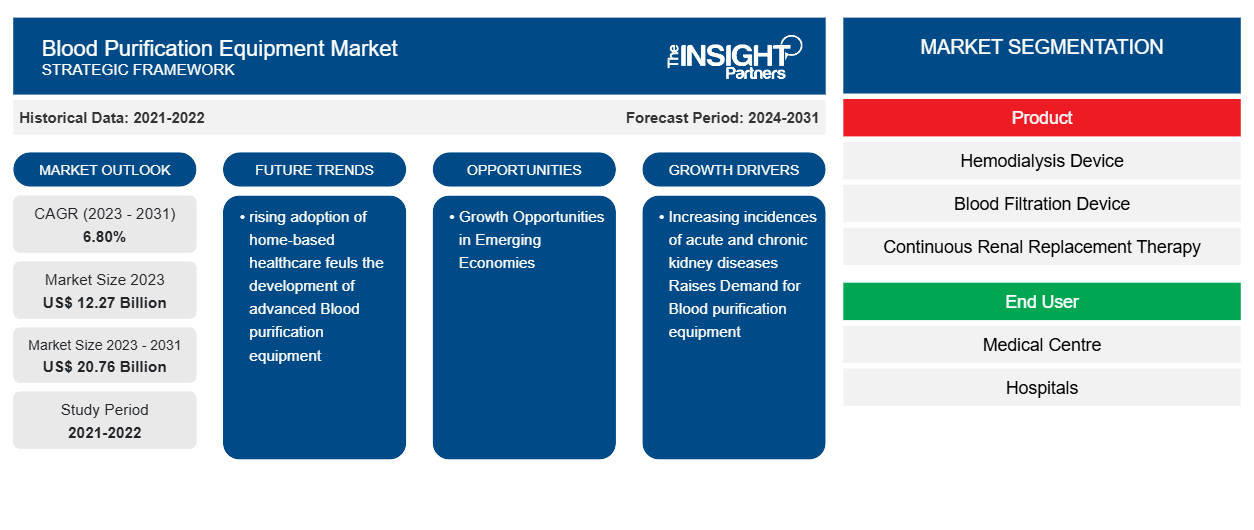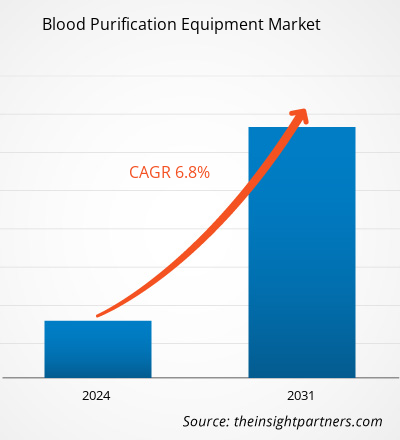The Blood purification equipment market size is projected to reach US$ 20.76 billion by 2031 from US$ 12.27 billion in 2023. The market is expected to register a CAGR of 6.80% during 2023–2031. The growing technological advancements in blood purification equipment will likely remain key trends in the market.
Blood Purification Equipment Market Analysis
Blood purification equipment utilizes advanced technologies such as hemodialysis, hemofiltration, and plasmapheresis to effectively filter and cleanse the blood. This ensures the optimal functioning of vital organs and improves overall patient outcomes. As the healthcare landscape continues to evolve, the demand for innovative blood purification solutions is expected to increase.
Blood Purification Equipment Market Overview
In 2023, Asia Pacific accounted for the fastest-growing region in the global blood purification equipment market and was projected to grow at a faster pace during 2023-2031. The blood purification equipment market in the region is majorly held by countries such as China and Japan. The factors including the high prevalence of patients suffering from chronic kidney diseases, the rising number of players operating across the country, and the rising development of blood purification technology are leading the growth of the blood purification equipment market in these countries. In January 2022, Kaneka Corporation, headquartered in Minato-ku, Tokyo announced construction of a new medical device plant in the Tomakomai Tohbu Industrial Area in Hokkaido, Japan's northern region. The company will invest ~ 10 billion yen (US$ 64.01 Billion) in this venture, with the plant expected to commence operations in May 2024. This new facility is incorporating advanced automation to enhance manufacturing processes and increase productivity and is aimed to meet the growing global demand and facilitate Kaneka's expansion in the international market.
Countries such as Australia, India, and South Korea are estimated to serve various growth opportunities due to the rising development in the healthcare industry and rising healthcare expenditures.
Customize This Report To Suit Your Requirement
You will get customization on any report - free of charge - including parts of this report, or country-level analysis, Excel Data pack, as well as avail great offers and discounts for start-ups & universities
Blood Purification Equipment Market: Strategic Insights

-
Get Top Key Market Trends of this report.This FREE sample will include data analysis, ranging from market trends to estimates and forecasts.
Blood Purification Equipment Market Drivers and Opportunities
Growing Incidences and Prevalence of Chronic Kidney Diseases to Favor Market
Chronic kidney disease (CKD) is a condition in which the kidneys are damaged and cannot filter blood properly. Because of this, excess fluid and waste from blood remain in the body, which may cause other health problems such as heart disease and stroke. CKD usually worsens over time, even though treatment has shown slow progression which results in human kidneys to stop working completely and requires performing dialysis that helps to filter and purify the blood with the help of an external machine. These machines known as hemodialysis devices contributes a major share in the blood purification equipment market.
Additionally, rising prevalence of diabetes among the population has increased the risk of renal diseases. According to the International Diabetes Federation (IDF) in 2021, ~ 537 million adults worldwide were living with diabetes. This number is further projected to rise to 643 million by 2030 and 783 million by 2045.
Growth Opportunities in Emerging Economies
Some emerging countries such as India, China, Hong Kong, Indonesia, Malaysia, Singapore, South Korea, and Thailand have grown much faster and more consistently than many high upper income economies. This is due to the development of their healthcare facilities and services and the technological advancements by nations. According to the American Society of Nephrology report, the survival of patients on dialysis is one of the best in Japan owing to factors such as a better prognosis for Japanese patients undergoing dialysis, including more intensive care and broader coverage of drugs, buy the healthcare insurance.
Additionally, in India, the National Health Mission (NHM) offers 100 % free dialysis treatment for patients belonging to the below poverty line (BPL) economic group. Furthermore, the State Government of India are entering into Public Private Partnership for Hemodialysis services. The private partners provide medical human resource, dialysis machine, Reverse Osmosis (RO) water plant infrastructure, and consumables within the District Hospital.
Therefore, the above mentioned factors are expected to provide an opportunistic scenario for the growth of blood purification equipment market during 2023-2031.
Blood Purification Equipment Market Report Segmentation Analysis
Key segments that contributed to the derivation of the Blood purification equipment market analysis are product and end user.
- The blood purification equipment market is segmented based on product into hemodialysis device, blood filtration device, continuous renal replacement therapy (CRRT) device, hemoperfusion device, plasma exchange device. The hemodialysis device segment held the largest market share in 2023.
By end user, the market is segmented into medical centre, hospitals, and others. The hospitals segment held the largest market share in 2023.
Blood Purification Equipment Market Share Analysis by Geography
The geographic scope of the Blood purification equipment market report is mainly divided into five regions: North America, Asia Pacific, Europe, Middle East & Africa, and South & Central America.
North America holds the largest market share of the next-generation sequencing market. The Blood purification equipment market in North America is analyzed based on three major countries: the US, Canada, and Mexico. The US is estimated to have a larger share of the North America Blood purification equipment market in 2023. The blood purification market in the US is expected to grow due the rising advancements for blood purification procedures. The country has well-developed healthcare facility centers equipped with highly advanced equipment and instruments. The country is also experiencing increasing incidences of acute kidney injury (AKI), multiple organ dysfunction syndrome or sepsis, end-stage renal disease, and others.
Blood Purification Equipment Market Regional Insights
The regional trends and factors influencing the Blood Purification Equipment Market throughout the forecast period have been thoroughly explained by the analysts at The Insight Partners. This section also discusses Blood Purification Equipment Market segments and geography across North America, Europe, Asia Pacific, Middle East and Africa, and South and Central America.
Blood Purification Equipment Market Report Scope
| Report Attribute | Details |
|---|---|
| Market size in 2023 | US$ 12.27 Billion |
| Market Size by 2031 | US$ 20.76 Billion |
| Global CAGR (2023 - 2031) | 6.80% |
| Historical Data | 2021-2022 |
| Forecast period | 2024-2031 |
| Segments Covered |
By Product
|
| Regions and Countries Covered |
North America
|
| Market leaders and key company profiles |
|
Blood Purification Equipment Market Players Density: Understanding Its Impact on Business Dynamics
The Blood Purification Equipment Market is growing rapidly, driven by increasing end-user demand due to factors such as evolving consumer preferences, technological advancements, and greater awareness of the product's benefits. As demand rises, businesses are expanding their offerings, innovating to meet consumer needs, and capitalizing on emerging trends, which further fuels market growth.

- Get the Blood Purification Equipment Market top key players overview
Blood Purification Equipment Market News and Recent Developments
The blood purification equipment market is evaluated by gathering qualitative and quantitative data from primary and secondary research, which includes essential corporate publications, association data, and databases. A few of the developments in the Blood purification equipment market are listed below:
- Kaneka Corporation obtained approval for the manufacture and sale of its adsorption type blood purification device called Rheocarna. This device is designed to treat a severe form of arteriosclerosis obliterans (ASO) that results in lower limb ulcers. The product was aimed to launch in the spring of 2021 after it is covered by health insurance. (Source: Kaneka Corporation, Press Release, 2020)
- Braun Avitum AG and CytoSorbents Corporation announced a global co-marketing agreement to promote the OMNI Continuous Blood Purification Platform with CytoSorb. The joint marketing of CytoSorb with B. Braun's newest OMNI blood purification platform was aimed to provide critically ill patients with greater access to this advanced treatment for deadly inflammation. (Source: Braun Avitum AG, Press Release, 2021)
Blood Purification Equipment Market Report Coverage and Deliverables
The “Blood Purification Equipment Market Size and Forecast (2021–2031)” report provides a detailed analysis of the market covering below areas:
- Blood purification equipment market size and forecast at global, regional, and country levels for all the key market segments covered under the scope
- Blood purification equipment market trends, as well as market dynamics such as drivers, restraints, and key opportunities
- Detailed PEST/Porter’s Five Forces and SWOT analysis
- Blood purification equipment market analysis covering key market trends, global and regional framework, significant players, regulations, and recent market developments
- Industry landscape and competition analysis covering market concentration, heat map analysis, prominent players, and recent developments in the Blood purification equipment market
- Detailed company profiles
Frequently Asked Questions
Which region dominated the blood purification equipment market in 2023?
What are the driving factors impacting the Blood purification equipment market?
What are the future trends of the Blood purification equipment market?
Which are the leading players operating in the Blood purification equipment market?
What would be the estimated value of the blood purification equipment market by 2031?
What is the expected CAGR of the Blood purification equipment market?
- Historical Analysis (2 Years), Base Year, Forecast (7 Years) with CAGR
- PEST and SWOT Analysis
- Market Size Value / Volume - Global, Regional, Country
- Industry and Competitive Landscape
- Excel Dataset
Recent Reports
Related Reports
Testimonials
Reason to Buy
- Informed Decision-Making
- Understanding Market Dynamics
- Competitive Analysis
- Identifying Emerging Markets
- Customer Insights
- Market Forecasts
- Risk Mitigation
- Boosting Operational Efficiency
- Strategic Planning
- Investment Justification
- Tracking Industry Innovations
- Aligning with Regulatory Trends





















 Get Free Sample For
Get Free Sample For